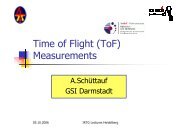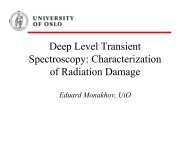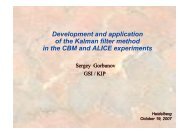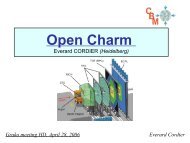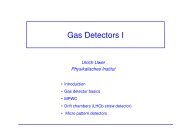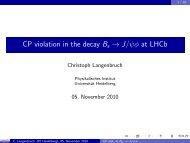Alexander Tadday Kirchhoff Institute for Physics ... - IRTG Heidelberg
Alexander Tadday Kirchhoff Institute for Physics ... - IRTG Heidelberg
Alexander Tadday Kirchhoff Institute for Physics ... - IRTG Heidelberg
You also want an ePaper? Increase the reach of your titles
YUMPU automatically turns print PDFs into web optimized ePapers that Google loves.
Application of Birks' law of<br />
scintillator nonlinearity in<br />
Geant4<br />
<strong>Alexander</strong> <strong>Tadday</strong><br />
<strong>Kirchhoff</strong> <strong>Institute</strong> <strong>for</strong> <strong>Physics</strong><br />
<strong>Heidelberg</strong> University<br />
<strong>Alexander</strong> <strong>Tadday</strong> <strong>Alexander</strong> - <strong>IRTG</strong> <strong>Tadday</strong> Meeting - <strong>IRTG</strong> - <strong>Heidelberg</strong> Meeting - 05.11.2010
2<br />
Outline<br />
• CALICE analogue hadronic calorimeter prototype<br />
• Birks’ law of scintillator nonlinearity<br />
• Measurement of Birks’ coefficient (MPIK <strong>Heidelberg</strong>)<br />
• Birks’ law in Geant4<br />
• Conclusion & Discussion<br />
<strong>Alexander</strong> <strong>Tadday</strong> - <strong>IRTG</strong> Meeting - 05.11.2010
3<br />
CALICE analogue HCAL<br />
• Hadronic calorimeter prototype <strong>for</strong><br />
next e + e - collider<br />
• Sampling calorimeter with small plastic<br />
(polystyrene) tiles as active material<br />
• Monte Carlo studies<br />
➜ Scintillator properties needed<br />
• Nonlinearity: Birks’ law<br />
• Currently Birks’ coefficient from ZEUS<br />
calorimeter scintillator is used<br />
• Measure kB <strong>for</strong> the AHCAL scintillator<br />
Mirror<br />
Plastic scintillator tile (3×3×0.5cm 3 )<br />
Wavelength<br />
shifting fibre<br />
SiPM<br />
<strong>Alexander</strong> <strong>Tadday</strong> - <strong>IRTG</strong> Meeting - 05.11.2010
4<br />
Birks’ Saturation Formula<br />
e -<br />
• Specific energy loss dE/dx is<br />
high be<strong>for</strong>e particle is stopped<br />
• High ionization density<br />
dI/dx α dE/dx<br />
• Quenching: Excited atoms<br />
can interact and may de-excite radiationless<br />
• Light yield per unit length dL/dx is reduced <strong>for</strong> high dE/dx<br />
• Non-linearity described<br />
by Birks’ <strong>for</strong>mula:<br />
scintillator<br />
dE/dX [MeV/cm]<br />
3500<br />
3000<br />
2500<br />
2000<br />
1500<br />
1000<br />
500<br />
0<br />
0.0005 0.001 0.0015 0.002<br />
kin energy [MeV]<br />
Electron collision stopping power<br />
(Berger-Seltzer eq.)<br />
<strong>Alexander</strong> <strong>Tadday</strong> - <strong>IRTG</strong> Meeting - 05.11.2010
Experimental Setup (MPIK <strong>Heidelberg</strong>)<br />
5<br />
• PMT measures light yield<br />
• Germanium detector measures Energy<br />
of Compton scattered photon EGe<br />
• Coincidence trigger PMT and Ge-detector<br />
• Measured energy range of electrons<br />
~ 30 - 140 keV<br />
• Thanks to Christoph Aberle and Stefan<br />
Wagner <strong>for</strong> the ability to use the setup<br />
• Detailed setup description in [1]<br />
Scintillator<br />
Germanium<br />
detector<br />
137 Cs<br />
moveable rail<br />
PMT<br />
<strong>Alexander</strong> <strong>Tadday</strong> - <strong>IRTG</strong> Meeting - 05.11.2010
Experimental Setup (MPIK <strong>Heidelberg</strong>)<br />
5<br />
• PMT measures light yield<br />
• Germanium detector measures Energy<br />
of Compton scattered photon EGe<br />
• Coincidence trigger PMT and Ge-detector<br />
• Measured energy range of electrons<br />
~ 30 - 140 keV<br />
• Thanks to Christoph Aberle and Stefan<br />
Wagner <strong>for</strong> the ability to use the setup<br />
• Detailed setup description in [1]<br />
Scintillator<br />
Germanium<br />
detector<br />
137 Cs<br />
moveable rail<br />
PMT<br />
<strong>Alexander</strong> <strong>Tadday</strong> - <strong>IRTG</strong> Meeting - 05.11.2010
6<br />
Total Light-Yield<br />
We have measured total Light-Yield (LY)<br />
Problem: dL/dx not easily measurable<br />
divide by dE/dx<br />
Light-Yield of a particle with energy E0:<br />
<strong>Alexander</strong> <strong>Tadday</strong> - <strong>IRTG</strong> Meeting - 05.11.2010
7<br />
kB Measurement (standalone)<br />
• Experimental data:<br />
Light-yield as function<br />
of electron energy<br />
• Fit with calculated<br />
Light yield<br />
➜ Fit parameter kB<br />
Light yield [a.u.]<br />
4000<br />
3500<br />
3000<br />
2500<br />
2000<br />
1500<br />
1000<br />
500<br />
0<br />
0 0.02 0.04 0.06 0.08 0.1 0.12 0.14<br />
Fit function: Kinetic energy [MeV]<br />
Fit result:<br />
kB=0.0151 cm/MeV<br />
Currently used value:<br />
kB = 0.007943 cm/MeV<br />
M. Hirschberg et. al.,<br />
IEEE Trans. Nucl. Sc., Vol. 39, No. 4, 1992<br />
Data<br />
Birks' model<br />
Linear fit (fit range > 0.12MeV)<br />
<strong>Alexander</strong> <strong>Tadday</strong> - <strong>IRTG</strong> Meeting - 05.11.2010
8<br />
Birks’ coefficient in Geant4<br />
• Geant4 is step based:<br />
E0 E1 En-1 En=0<br />
dx1 dx2 dxn<br />
• Steps can’t be arbitrarily small because of computational<br />
ef<strong>for</strong>t<br />
• Light-Yield in Geant4 (secondaries not considered):<br />
• Converges only against integral <strong>for</strong> small steps.<br />
This is not the case <strong>for</strong> default settings in Geant4!<br />
<strong>Alexander</strong> <strong>Tadday</strong> - <strong>IRTG</strong> Meeting - 05.11.2010
8<br />
Birks’ coefficient in Geant4<br />
• Geant4 is step based:<br />
E0 E1 En-1 En=0<br />
dx1 dx2 dxn<br />
• Steps can’t be arbitrarily small because of computational<br />
ef<strong>for</strong>t<br />
• Light-Yield in Geant4 (secondaries not considered):<br />
• Converges only against integral <strong>for</strong> small steps.<br />
This is not the case <strong>for</strong> default settings in Geant4!<br />
<strong>Alexander</strong> <strong>Tadday</strong> - <strong>IRTG</strong> Meeting - 05.11.2010
9<br />
Birks’ coefficient in Geant4<br />
E<br />
!<br />
/<br />
vis<br />
E<br />
!<br />
1<br />
0.8<br />
0.6<br />
0.4<br />
0.2<br />
0<br />
Curve shows 120keV e - with<br />
kB=0.0151cm/MeV<br />
Area under curve<br />
represents the<br />
visible energy<br />
0 0.02 0.04 0.06 0.08 0.1 0.12<br />
Kinetic energy [MeV]<br />
<strong>Alexander</strong> <strong>Tadday</strong> - <strong>IRTG</strong> Meeting - 05.11.2010
9<br />
Birks’ coefficient in Geant4<br />
Geant4 with default<br />
settings and<br />
kB=0.0151cm/MeV<br />
Visible energy is<br />
! E<br />
/<br />
vis<br />
! E<br />
1<br />
0.8<br />
overestimated! Area under curve<br />
0.6<br />
0.4<br />
0.2<br />
0<br />
Curve shows 120keV e - with<br />
kB=0.0151cm/MeV<br />
step 2<br />
represents the<br />
visible energy<br />
step 1<br />
0 0.02 0.04 0.06 0.08 0.1 0.12<br />
Kinetic energy [MeV]<br />
<strong>Alexander</strong> <strong>Tadday</strong> - <strong>IRTG</strong> Meeting - 05.11.2010
9<br />
Birks’ coefficient in Geant4<br />
Geant4 with default<br />
settings and<br />
kB=0.0151cm/MeV<br />
Visible energy is<br />
Possible solution:<br />
Use “effective” Birks’<br />
coefficient to get the<br />
correct result<br />
kB=0.0186cm/MeV<br />
! E<br />
/<br />
vis<br />
! E<br />
1<br />
0.8<br />
overestimated! Area under curve<br />
0.6<br />
0.4<br />
0.2<br />
0<br />
Curve shows 120keV e - with<br />
kB=0.0151cm/MeV<br />
step 2<br />
represents the<br />
visible energy<br />
step 1<br />
0 0.02 0.04 0.06 0.08 0.1 0.12<br />
Kinetic energy [MeV]<br />
<strong>Alexander</strong> <strong>Tadday</strong> - <strong>IRTG</strong> Meeting - 05.11.2010
10<br />
effective Birks' coefficient [cm/MeV]<br />
Birks’ coefficient in Geant4<br />
0.019<br />
0.018<br />
0.017<br />
0.016<br />
0.015<br />
0.014<br />
0.013<br />
0.012<br />
10<br />
-14<br />
-12<br />
10<br />
-10<br />
10<br />
-8<br />
10<br />
-6<br />
10<br />
-4<br />
10 10 1<br />
Final range parameter [m]<br />
qualitatively:<br />
smaller steps larger steps<br />
default Geant4<br />
settings:<br />
α = 0.2<br />
Final range = 1mm<br />
-2<br />
<strong>Alexander</strong> <strong>Tadday</strong> - <strong>IRTG</strong> Meeting - 05.11.2010
10<br />
effective Birks' coefficient [cm/MeV]<br />
Birks’ coefficient in Geant4<br />
0.019<br />
0.018<br />
0.017<br />
0.016<br />
0.015<br />
0.014<br />
0.013<br />
0.012<br />
10<br />
qualitatively:<br />
-14<br />
Main disadvantage:<br />
need different effective Birks’<br />
coefficient <strong>for</strong> different<br />
parameter configuration<br />
-12<br />
10<br />
-10<br />
10<br />
-8<br />
10<br />
-6<br />
10<br />
-4<br />
10 10 1<br />
Final range parameter [m]<br />
smaller steps larger steps<br />
default Geant4<br />
settings:<br />
α = 0.2<br />
Final range = 1mm<br />
-2<br />
<strong>Alexander</strong> <strong>Tadday</strong> - <strong>IRTG</strong> Meeting - 05.11.2010
11<br />
• Step-wise integral<br />
calculation of visible<br />
energy<br />
• Use method of Monte<br />
Carlo integration<br />
(VEGAS algorithm)<br />
• Use pre-calculated<br />
dE/dX to increase<br />
speed<br />
Method Improvement<br />
Default Geant4 Default Geant4<br />
E<br />
!<br />
/<br />
vis<br />
E<br />
!<br />
1<br />
0.8<br />
0.6<br />
0.4<br />
0.2<br />
0<br />
0 0.02 0.04 0.06 0.08 0.1 0.12<br />
Kinetic energy [MeV]<br />
<strong>Alexander</strong> <strong>Tadday</strong> - <strong>IRTG</strong> Meeting - 05.11.2010
12<br />
• Birks’ coefficient<br />
independent of final<br />
range parameter<br />
(step-size)<br />
• Residual fluctuation<br />
from production of<br />
secondaries (deltaelectrons)<br />
Method Comparison<br />
effective Birks' coefficient [cm/MeV]<br />
0.019 Default Geant4<br />
0.018<br />
0.017<br />
0.016<br />
0.015<br />
0.014<br />
0.013<br />
0.012<br />
10<br />
-14<br />
-12<br />
10<br />
Integral method<br />
-10<br />
10<br />
-8<br />
10<br />
-6<br />
10<br />
10 10 1<br />
Final range parameter [m]<br />
qualitatively:<br />
smaller steps larger steps<br />
<strong>Alexander</strong> <strong>Tadday</strong> - <strong>IRTG</strong> Meeting - 05.11.2010<br />
-4<br />
-2
13<br />
Conclusion & Outlook<br />
• Measured Birks’ coefficient higher than currently used one<br />
Measured value: kB = 0.0151cm/MeV (“old”: kB = 0.007943cm/MeV)<br />
• Default Geant4: Effective Birks’ coefficient needed in order to describe<br />
data correctly (kB is step-size dependent)<br />
• Integral method allows to calculate precisely the visible energy deposition<br />
<strong>for</strong> each step (kB is step-size independent)<br />
• To Do<br />
• Study influence of new kB and new method on simulated particle<br />
showers<br />
• Test per<strong>for</strong>mance of integral method<br />
<strong>Alexander</strong> <strong>Tadday</strong> - <strong>IRTG</strong> Meeting - 05.11.2010
14<br />
Reference(s)<br />
• [1] Stefan Wagner, “Ionization Quenching by Low Energy Electrons in the Double Chooz<br />
Scintillators”, Diploma Thesis (2010)<br />
<strong>Alexander</strong> <strong>Tadday</strong> - <strong>IRTG</strong> Meeting - 05.11.2010
Backup<br />
15
16<br />
Step-limitation in GEANT4<br />
• Every registered process sets a limit on the the step-size<br />
• The smallest limit is chosen <strong>for</strong> each step<br />
• For ionization process, Stepping function determines the<br />
maximum step-size allowed Δxmax<br />
- ρ: Final range (Default value: 1mm)<br />
- α: dR/R (Default value: 0.2)<br />
(high energy)<br />
(low energy)<br />
➜ Small values of ρ and α result in a small step size<br />
<strong>Alexander</strong> <strong>Tadday</strong> - CALICE Collaboration Meeting - Casablanca - 23.09.2010
17<br />
[m]<br />
lim<br />
S<br />
!<br />
0.0035<br />
0.003<br />
0.0025<br />
0.002<br />
0.0015<br />
0.001<br />
0.0005<br />
Final range<br />
ρR=1mm<br />
Step Function<br />
“slope”<br />
αR=0.2<br />
0<br />
0 0.001 0.002 0.003 0.004 0.005 0.006 0.007 0.008 0.009<br />
Range [m]<br />
<strong>Alexander</strong> <strong>Tadday</strong> - CALICE Collaboration Meeting - Casablanca - 23.09.2010



